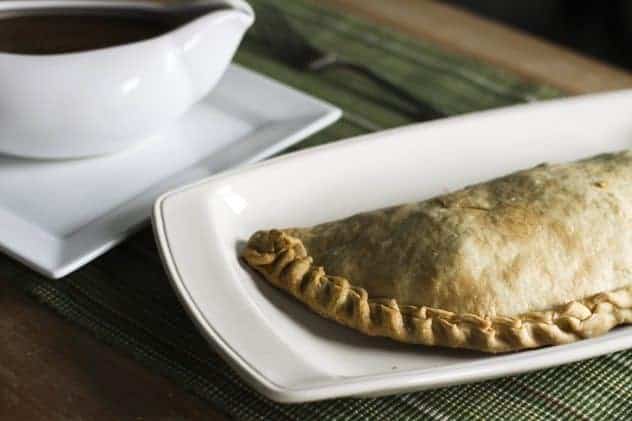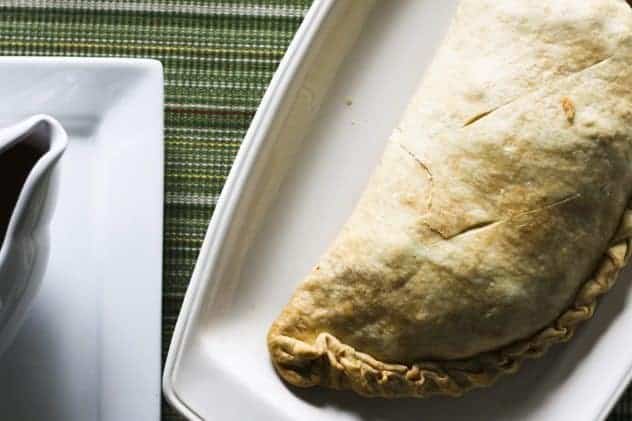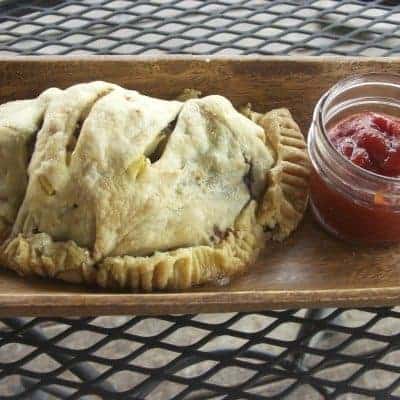Okay. Now those of my readers who are Yoopers (specifically) or Michiganders (generally) will know exactly what I’m saying. Those of you who don’t have kith or kin in either Michigan or Cornwall might need a little explanation. The pasties of which I speak are pronounced ‘PASS- tees’. The ones you’re probably thinking about are pronounced ‘PAY- steeze’. My pasties are handheld meat pies and not little adhesive backed ‘modesty’ panels worn over, well, you know what. So from now on, each time I type ‘pasties’, please think the correct pronunciation, k? That way I don’t have to blush every time you read it.
And also for those of you not from Michigan, I should probably toss in a few other definitions:
- Yooper: A resident of the Upper Peninsula of Michigan.
- U.P.: A widely used acronym for the Upper Peninsula of Michigan. Well, heck, you’d get tired of typing out Upper Peninsula of Michigan every time too, eh?
- Big Mac: A nickname for the Mackinac Bridge; the 5 mile long suspension bridge that links the U.P. to the lower Peninsula.
- Trolls: Residents of the Lower Peninsula of Michigan. Get it? They live under a bridge?
- Summer: Two months of bad snowshoeing.
But back to the food…
Pasties are a Yooper (and Cornish) specialty. The Cornish miners that came over to the Upper Peninsula during the golden era of iron and copper mining brought the pasty with them as part of their homeland’s cuisine. Owing partly to it’s convenient, hand-held-meal portability and mostly to the fact that it’s mouthwateringly delicious and warms you from the inside of your toes to the tips of your ears in cold U.P. weather, pasties were soon not just the fare of Finnish and Cornish miners, but were adopted as a favored food through the entire region. More than just popular in the U.P., though, pasties make an appearance in troll restaurants under Big Mac, too. One of the best in the northern part of the lower peninsula is Cousin Jenny’s in Traverse City, Michigan.
A pasty is so representative of Yooper culture and food that those of us who are Yoopers-in-exile get wistful when we whip up a batch or talk to relatives who just picked up their pasty boxes at the local church’s fundraising drives. I had actual hunger pangs when Val emailed me the ‘pasty order form’ from an insert in their church bulletin a few Sundays back. I pictured a couple dozen Finnish grandmas up in Marquette whipping together hundreds of succulent pasties to sell to benefit the local community chest, booster club, or whatever worthy group they decided to support that year.
Then I did what I often have to do when I finish talking to Val. I walked into my kitchen because I was starving. All that pasty talk had left me with two options; feeling sorry for myself or making my own. I decided to whip up a couple dozen pasties.
Perhaps ‘whip up’ is not the best description of the process involved in making pasties. It’s a bit of a job, but if you have sisu* you can manage.
*Sisu: A Finnish term that translates roughly into English as having an inner strength of will, obstinacy or persistence to power on in the face of adversity regardless of the cost.
I heard someone describe pasties once as ‘hand held beef stew pies”. I think beef stew wishes it was a pasty. While there are variations in pasties based on what the cook can get -beef, venison, chicken, turkey, etc…- and the ratios of vegetables there are some things you’re likely to find in them all. Potatoes, onions, carrots and rutabaga are the traditional pasty veggies and I’m happy to stick with them because you don’t mess with perfection! You’re not likely to hear me saying that often in the kitchen, but we’re talking about food as tradition when it comes to pasties, people. I admit that I frequently make cheese pasties, and they’re divine, but that’s a completely different animal than a Yooper pasty. Truth be known, I don’t think of the cheese ones as pasties. I think of them as cheese pastries. Delicious, to be sure, but in a different food family altogether.
Yooper Pasties
This recipe yields about 16 plate-sized pasties. Feel free to adjust amounts but you might want a few of these in your freezer. They’re the ultimate winter meal-in-one.

Yooper Pasties
Rate RecipeIngredients
- 1 large rutabaga and 1 small rutabaga peeled and diced
- 2 large carrots peeled and diced
- 2 medium onions peeled and diced
- 8 medium potatoes preferably a waxy variety like Yukon golds or reds, peeled and diced
- 4 pounds lean ground beef
- enough sturdy pie dough for eight double crust pies - I use the butter tart crust dough from the Fannie Farmer cookbook. If you need the recipe or eight boxes prepared refrigerated pie crusts, email me and I'll happily pass it along!
- salt and pepper to taste
Notes
Nutritional information is an estimate and provided to you as a courtesy. You should calculate the nutritional information with the actual ingredients used in your recipe using your preferred nutrition calculator.
did you make this recipe?
Make sure to tag @foodiewithfam on Instagram and #hashtag it #foodiewithfamily so I can check it out!
First you are going to sharpen your knife so that if you slip and take off a finger while wrestling your rutabaga it’ll be easier to reattach. I kid. Sort of. My point is this. Exercise caution with the rutabaga because it does not go gently into that good night.
The best way to prepare the recalcitrant little beast is to slice a sliver off one end of the rutabaga so that it stands sturdily on your cutting board. Then use your biggest sharpest knife to lob it in half. If it’s freaking you out too much to try to hold a slippery, wax covered, round and really hard vegetable while trying to cut it, feel free to whack it in half with a hatchet or an axe. Just don’t do it on your kitchen counter!
Once you have the brute opened, lay it on the flat side and dismantle it further so your original sphere is in quarters. Take another little bit off the bottom so you can stand the quarters up on their ends and use another sharp knife to remove the peel from the insides.
From this point on, cut the rutabaga into 1/4″ slices and stack them like a deck of cards.
Now you’ll take your rutabaga cards and slice them into 1/4″ strips that will then be cut into 1/4″ cubes. Isn’t that wonderfully symmetrical? Combine all diced vegetables in a gigantic mixing bowl. Break up ground beef over the top, add salt and pepper to taste, and mix up thoroughly.
Roll out a piece of pie crust to a diameter between 8″ and 10″. Lay on a pie plate with the crust hanging over the lip of the plate by about 1/4″. Use your hands or a large spoon to transfer as much filling onto the crust as you can, mounding and pressing down lightly with your hands, to fill the half of the crust that is hanging over the plate.
Now fold the empty part of the pie crust over the filling, pinch the seams together, transfer to your countertop and crimp the edges with a fork. Using yet another sharp knife, slice three little vents into the top of the pasty and transfer it to a baking dish or parchment lined baking pan.
Now slide those pans into a preheated 375°F oven and bake for 45 minutes to an hour. Since pasties don’t traditionally get an egg glaze, they won’t be a shiny brown when done, but a deep crispy looking golden brown. Oh I’m getting so hungry talking about these.
Serve hot, cold, or anything in between. My Dad used to heat his pasties up on the steam-pipe at the factory where he worked or on the manifold of the log skidder he operated. I meant it when I said they were portable!
To eat in true Yooper fashion, smother with good ketchup. If you have an aversion to ketchup you can serve with whatever gravy you prefer. Either way they’re soooooo good.





Reader's Thoughts...
Cindy says
My grandparents were yupers and we grew up on Pasty with catchup. No better to eat them. I have kept the tradition going for years. I never fully had a recipe, didn’t use rutabaga. Your recipe is the first I ran across that works for me. Basic but so yummy.
Rebecca says
Thanks so much for taking the time to rate the recipe and let me know you love it, Cindy!
Ken says
We need more Yooper recipies! It is REAL food!
Robin says
I would love to get your pie crust recipe. I can’t wait to make these. Thank you!
Carolyn Kibbe says
One suggestion to give the pasty the Yooper taste that I miss: I put all of the vegetables in the bowl and nuke them for about 6 minutes. Then mix in cooked ground beef. It makes sure that you get that homogeneous pasty innards taste like in the Au Train grocery.
Donna says
Hello, I believe there is a process to the ground meat before add
Vegetables. I’ve had many pasties in my time.
The meat used is very light and fluffy.
Looks like they whip it.
Rather than just putting the meat on top and mixing with your hands.
Note: email is zeros
Dorothy Pojeky says
I made some today. However, eating one; I used lard, salt and pepper in the mixture but I a thinking that I need some kind of another spice or others to make then taste better.
Any suggestions?????
Rebecca says
Hey there, Dorothy!! How about a little fresh grated nutmeg? I always love that in combination with meat and potatoes!
Jennifer says
Maybe you didn’t use enough salt and pepper. Some people add a little parsley. I add a pat of butter to the meat and vegetable mixture before folding over the dough.
Maya:) says
Thanks so much for this!!! I consider myself an honorary Yooper (a California girl, but I lived in Marquette & taught at Northern for 14 years). I’m back in CA now, and was so sad when Jean Kay’s closed and I didn’t get a chance to order some shipped to me. So I decided to make some.
I appreciate your recipe, your background/ historical info about pasties, and your humor. I kept having to read parts to my mom. We’re vegetarian, so I made modifications, but you recipe helped a lot!! Thanks you!!!
Rebecca says
You’re very welcome, Maya! I’m so glad I could help scratch that food itch for you!!
The Pasty Hunter says
Never, ever, EVER under any circumstances should you put carrots in a pasty
Signed
Every Cornishman and woman who ever lived!
Rebecca says
But consider putting carrots in a pasty if you’re anyone who has ever had a pasty outside of Cornwall because they’re delicious.
Signed,
An Independent Yooper Who Finds Carrots Tasty in Pasties.
Maryhelen says
Hi, I haven’t tried the recipe yet but I’m going to when I get hone after winter. I’m still in the lower Michigan. But I was raised in Marquette, so I’m well familiar with pasties. I now live 12 miles south from the Mackinac Bridge. Love them. I will be using a gluten free pie crust recipe as I have Celiac. My crust used to break . So pastries making was out of the question. However I found out recently that Psyllium husk works great as it makes the dough more playable and. Easier to use. You mix. Small amount of the Psyllium with some water and it makes a gel, then just make a regular gluten free pie crust. Also can be used in breads and all kinds of rolls that I thought I’d never be able to enjoy again. I like that your recipe calls for only a small amount of carrots and lots of rutabaga and. Potatoes. Wish I could start making some now. Oh well Aprils only a couple of months away. I’ll respond with another comment after I make them. Happy Spring.😊
Rebecca says
Thanks so much, Maryhelen! I’m so glad you’ve found a solution to be able to keep enjoying pasties! I look forward to hearing what you think after you make them. <3
Retta says
MaryEllen, I have the original pasty recipe which came from my Grandmother when She and Grandpa came from England thru Ellis Island to the upper Peninsula. Many were hired ,(as Grandpa was by the mining company) to work in the iron mines. They were provided a home to live in also by the mining company. Old mining locations are still all around ,remodeled and lived in by numerous families today. At any rate the pasty recipe has been remodeled by many. If you want the original recipe go to the Methodist Church Calumet, MI website. And search their recipe. It is the way my Grandmother made them also. Four ingredients! Flank steak,potato, rutabaga. Onion.,salt and pepper and a bit of beef suet crumbled. (A bit of butter if suet is not available. The crust is also made with a bit of suet, flour and water and a little salt.
Ann says
My parents were from Ontonagon and your recipe is the one we always use. I love Syles restaurant’s pasties! I make mine in a pan with only the top crust. Less carbohydrates for me. We love them.
Rebecca says
Thanks so much, Ann! I’m so glad you love it!!!